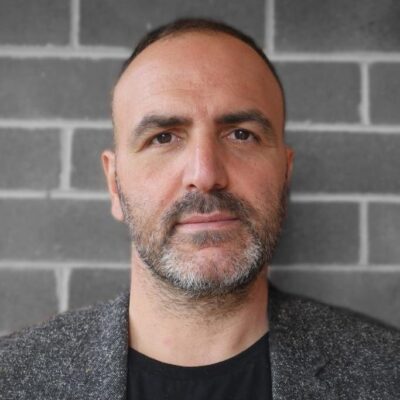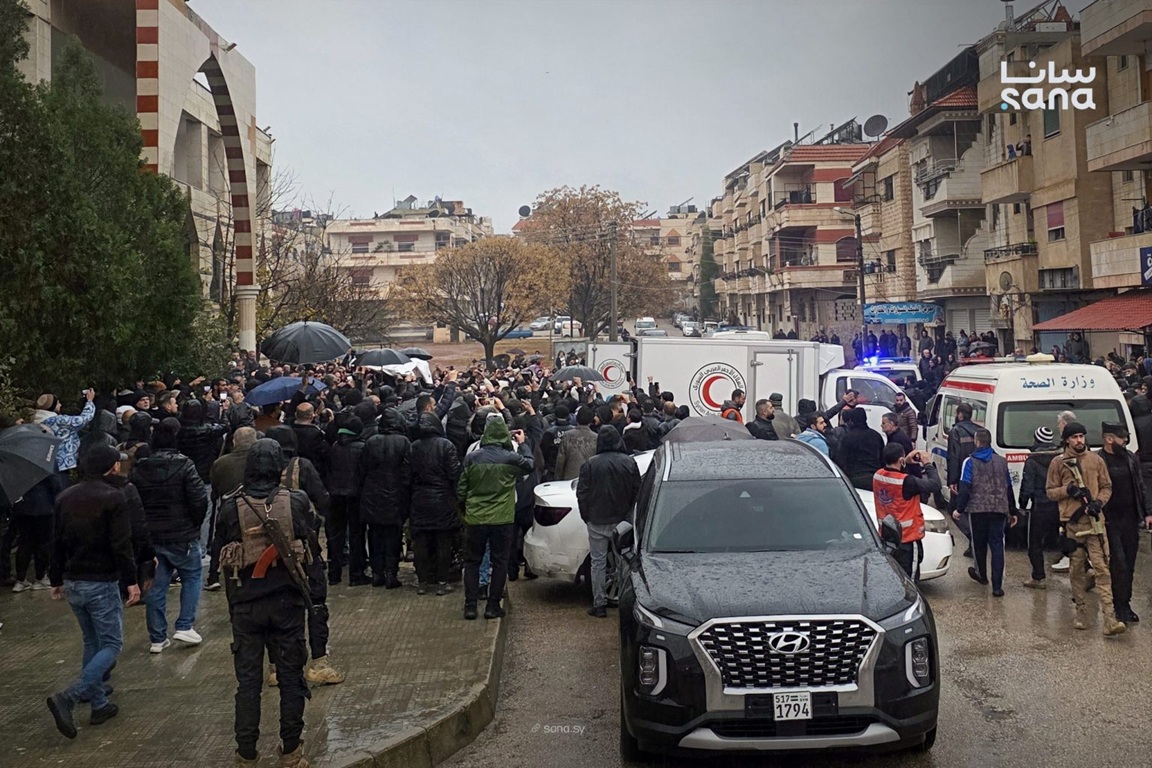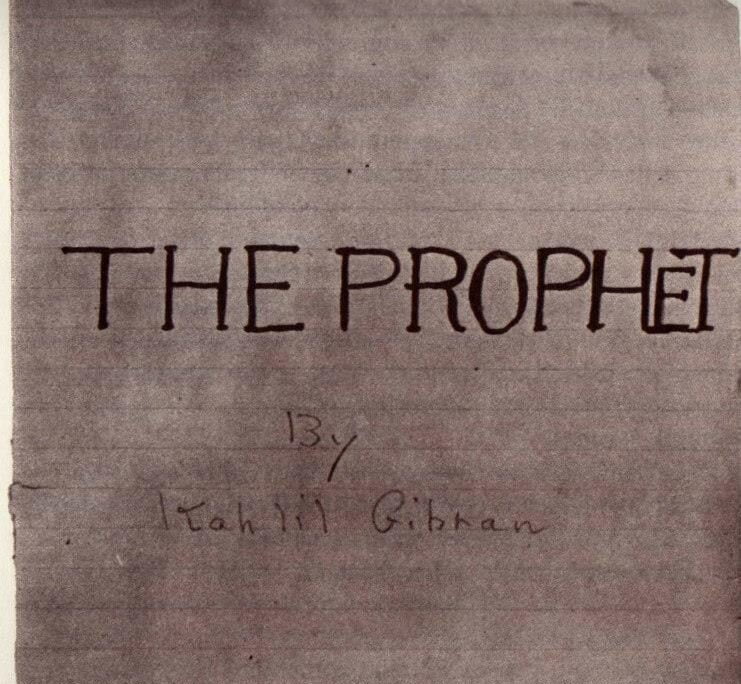
“I have come to say a word...but if death prevents my word the book of eternity will not leave a word unspoken. What I do today in my solitude will be echoed tomorrow by the multitude.” - Kahlil Gibran
Not long ago, I was asked to verify the official number of translations of Kahlil Gibran’s crowning jewel, The Prophet. This was not the first request of its kind. Still, it came at a good time, where the right partner (my fellow researcher Francesco Medici), tools, and information were aligned in such a way as to provide both the desire and motivation for this undertaking. What we found was no less than awe-inspiring.
By Glen Kalem
For years Gibran scholars have either grappled with conducting such an in-depth study or relied on un-scientific figures that Gibran enthusiasts published. As I’ve mentioned in previous articles, this discrepancy is likely also due to the lack of focused international research and study associated with the author himself. The earlier uncertainty surrounding his work can be traced back to his publisher, Alfred A. Knopf, who ironically once stated of Gibran’s work: “It must be a cult, but I have never met any of its members. I haven’t met five people who read Gibran” … I never understood him.” The result is that over the last 95 years, since the publication of the Prophet in 1923, unofficial worldwide numbers of the translation have never been accurately recorded. Current estimates remain at around 40-60 translations [2], not nearly enough to make it onto existing lists of the most translated books of all time [3]
This is why a handful of researchers, including myself, have long lobbied for reliable fact-based studies that will finally give some concrete ground to the widely recognised claim today that Gibran is one of the "most read poets in history." And now, upon completion of our initial research, we are pleased to announce our discovery: Kahlil Gibran’s The Prophet has been translated over 100 times, making it among the top ten most translated books in history!
To put the book and our research into perspective, let’s peel back the remarkable publishing and translation numbers that existed before this study occurred. According to its publisher A. Knopf, The Prophet, first published in 1923, has been reprinted an astounding 188 consecutive times in its 95-year history, making it one of the longest-running of any published works with an estimated worldwide readership of 100 million. I says “estimated” because some countries, for example in parts of Southeast Asia, have not adhered to copyright laws and so readership there may be much more widespread than we think—in fact, these are just some of the regions where I have found that Gibran's readership is growing in large numbers and not showing any sign of slowing down (for example, China alone boasts at least 15 full and part translations of The Prophet).
As this timely study coincides with the end of the publisher’s worldwide copyright privileges, we expect the numbers to keep climbing and wanted to have the current number officially on the record before that happens. After 95 years, publishers Alfred A. Knopf, now owned by Random House Penguin, will no longer have copyright authority over the original works in English by the end of 2018. This means we can expect to see many more iterations of The Prophet and related material around the world, beginning in January 2019--an exciting prospect indeed!
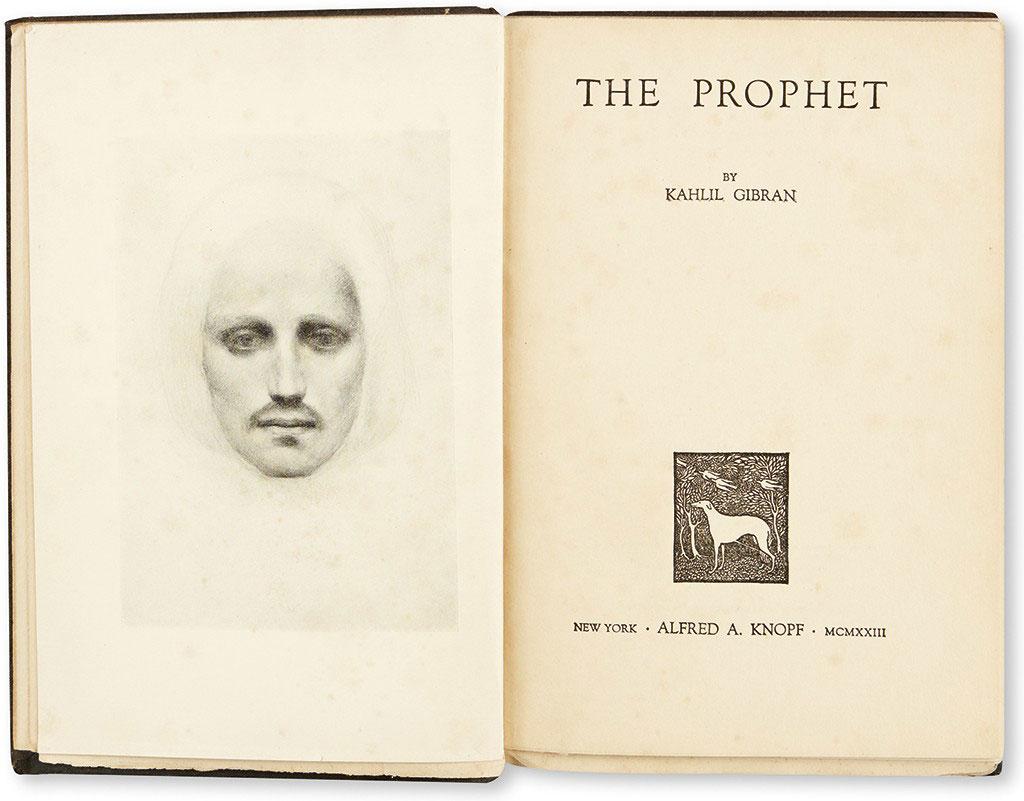
My colleague and fellow Gibran researcher Francesco Medici and I always knew Gibran's readership was more significant than estimated. So we began our search by tapping into online library archives and our international networks in search of the numbers. What we found far exceeded our expectations and surprised even those who thought they knew all there was to know about Gibran!
To our knowledge, no such comprehensive study has been conducted up until now, at least not by an academic or private institution. Furthermore, this study has not analysed each translation in greater detail, and the debate and discussion on the authenticity of each individual text is a whole different study in itself. We have simply tallied and collated to reach a base number of available texts from which we have a solid foundation to build upon.
All translations in this study were counted based on first editions only, and we have verified each listed work by citing at least the writer and publisher of the text. We did not, however, have the capacity to review the full contents of each work individually, nor test the accuracy of the poetic message and how that relates back to the virtue of the original. Furthermore, it is difficult to tell if the translators translated the work from the original English form or some other language. In summary, we solely focused on the existence and authenticity of the publication itself.
We began at The Kahlil Gibran Museum in Lebanon under the guidance of Mr. Joe Jaja, who sent us a list of 49 translations from the museum’s private collection. Building on this official list, we verified each copy and quickly added a further four translations, therefore bringing the number to 53 translations, which was still within the publicly available range of 40-60.
Digging further into the research, Francesco and I would email our shared file back and forth in what became a daily ritual. “The List,” as we came to call it, was growing rapidly; to see The Prophet translated into such obscure languages like Assamese (Indian dialect), Occitan (Provincial France), Uygur (Xinjiang Uygur Autonomous Region China) and even extinct ones such as Katova or Laghu (Santa Isabel Island -Solomon Islands) was so incredibly astonishing.
As we carried on our research, the questions that kept coming to our mind were, “how many more are there?! And what part of the world are they to be found??” When we broke the 70 translations milestone, we thought it was time to ring the bells of celebration, but the numbers just kept coming, and week after week we found ourselves adding two, three or even five new translations to the list!
“List update: 82! 86!” became typical email subject lines, and when we reached 90 confirmed translations we were both astonished; naturally, we wondered, could there be a 100? Or even more? Was it possible we could hit the magic milestone of three digits?
We continued edging closer and closer (like finding a braille copy) to the magic number but as we got within reach of our desired target of 100 we reached a lull. Both of us empty of research currency, and after a couple of weeks of no updates, it finally came--the email we'd hoped for, affirming what no one had thought possible: “102 translations!”
Astonished, amazed and just plain bewildered, we both knew we’d discovered something extraordinary; this would usher in a new frontier with regards to Gibran’s chef-d'œuvre. The official total number of translations to date now sits at 104, a number no one could have guessed, not even the most ardent Gibran fan.
As the weeks went by and I contemplated this number, I began to wonder where this placed The Prophet in the rankings when it came to the most translated books. The answer? According to existing lists, The Prophet, with 104 translations, amazingly sits at number 10, just behind the book of Mormon. Even more astonishing is that when breaking down the list, The Prophet has yet achieved another milestone: the only book of prose-poetry to hold a top ten position.
This discovery is only the beginning as we have only included first editions of each translation and therefore have reason to believe the overall number could exceed well over 200 translations; for example, we know of 13-15 editions that exist in China alone, another 15-20 in France, and so on.
In remembering how profoundly The Prophet influenced my own life and work, it is deeply touching to be able to share the full extent of Gibran’s impact on different generations and cultures around the world. To think that a book which has had little to no promotional support in its 95-year history has reached such a level of readership is remarkable, especially when you measure it against other works with multi-million-dollar marketing campaigns.
Finally, as this study remains in progress while we expand past first editions, all updates and further announcements will be accessible at www.kahlilgibran.com
[1] Research and study by Glen Kalem and Francesco Medici
[2] https://www.bbc.com/news/magazine-17997163
[3] http://ingcointernational.com/the-20-most-translated-texts-in-history/
[4] A previous version of this article appeared in the Lebanese American University’s publication, “Gibran in the 21st Century: Lebanon’s Gift to the World.”
1st Editions
| # | Language /Dialect | Title | Publisher | Place of Publication | Editor | Copyright Date | Edition | Translator(s) | Cover Type | Pages | Notes |
|---|---|---|---|---|---|---|---|---|---|---|---|
| 1 | Afrikaans | Die profeet | J.L. Van Schaik | Pretoria | 1955 | 1st | Louis Fourie | 104 | |||
| 2 | Albanian | Profeti | Botimet Toena | Tirana | 2003 | 1st | Maksim Rakipaj | 71 | |||
| 3 | Alsatian | De Prophet | Atelier de Promotion de l'Alsacien | Zinswiller (France) | Fouad Alzouheir | 2013 | 1st | APECM | 130 | ||
| 4 | Amharic | YeTibeb Meniged (Nebiyu) | Commercial Publishing Enterprise | Addis Ababa (Ethiopia) | 2011 | 1st | Demelash Tiulahun, Tesfahun Mitiku, Habitamu Tesfaye | 192 | |||
| 5 | Arabic (Egypt) | al-Nabī | al-Maṭbaʻah al-Raḥmānīyah bi-Miṣr | Cairo | Antūniyūs Bashīr | 1926 | 1st | Antūniyūs Bashīr | 120 | ||
| 6 | Arabic (England) | al-Nabī | Elan Publications[?] | London | 2016 | 1st | Jamīl al-ʿĀbid | 115 | |||
| 7 | Arabic (Lebanon) | al-Nabī | Mu'assasat Nawfal | Beirut | Mikhail Naimy | 1956 | 1st | Mikhail Naimy | 108 | ||
| 8 | Armenian (Eastern) | Margarēn | Lebanese Embassy of Armenia | Yerevan | 2008 | 1st | Hovik Yordekian | 70 | |||
| 9 | Armenian (Western) | Margarēn | Tparan Kat̕oġikosowt̕ean Hayoc̕ Meçi Tann Kilikioy | Antelias (Lebanon) | Vahe-Vahian (Sarkis Abdalian) | 1983 | 1st | Vahe-Vahian (Sarkis Abdalian) | 103 | ||
| 10 | Assamese | Propheṭa | Natuna Asama | Guwahati (India) | 1994 | 1st | Jyotiprasād Śaikīẏā | 71 | |||
| 11 | Azerbaijani | Peyğəmbər | Qanun | Baku | 2014 | 1st | S. Bulut | 104 | |||
| 12 | Bahsa Aceh [Acehnese] | ??? | 1st | ||||||||
| 13 | Bangla | The Prophet | Ahmed Mahmudul Haque of Mowla Brothers | Dhaka, Bangladesh | 2009 | 1st | Chowdury Mushtaq Ahmed | 112 | |||
| 14 | Basque | Profeta | Arantzazu | Arantzazu (Basque Country) | 2008 | 1st | Patxi Ezkiaga | ||||
| 15 | Bengali | Dya prapheṭa | Amr̥taloka Sāhitya Parishada | Midnapore, India | 1993 | 1st | Ajita Miśra | 84 | |||
| 16 | Berber | Amusnaw | L'Harmattan | Paris | Youcef Allioui | 2014 | 1st | Youcef Allioui | 122 | ||
| 17 | Bikol | An Profeta | Ina Nin Bikol Foundation | Naga City | Bernie Faustine D. Brijueg | 2013 | 1st | Fr. Wilmer Joseph S. Tria | |||
| 18 | Bulgarian | Prorokŭt | Kibea | Sofia | 1997 | 1st | Maya Tzenova | ||||
| 19 | Cebuan | Ang Propeta | Sun Star Pub. | Cebu City (Philippines) | 2009 | 1st | Jesus "Sonny" Garcia, Jr. | 138 | |||
| 20 | Croatian | Prorok | GZH | Zagreb | 1985 | 1st | Marko Grcic | Paperback | |||
| 21 | Croatian | Prorok | GZH | Zagreb | 1985 | 1st | Marko Grcic | Paperback | |||
| 22 | Czech | Prorok | Prota: Ludvík Souček [distributor] | Prague | 1932 | 1st | Oldřich Hlaváč | ||||
| 23 | Danish | Profeten | Lindhardt og Ringhof | Copenhagen | 1987 | 1st | Per Thorrell | ||||
| 24 | Dutch (Belgium) | De profeet | De Nederlandsche Boekhandel | Kapellen | 1977 | 1st | Carolus Verhulst | 120 | |||
| 25 | Dutch (Netherlands) | De profeet | ? | The Hague | 1927 | 1st | Liesbeth Valckenier-Suringar | 98 | |||
| 26 | English (Braille) | The Prophet | Division for the Blind and Physically Handicapped | Washington, D.C. (USA) | 1951 | 1st | |||||
| 27 | Esperanto (artificial language) | La Profeto | Eldonejo Stafeto - Juan Régulo Pérez | [San Cristóbal de] La Laguna, Tenerife, Canary Islands (Spain) | Elías F. Shamon | 1962 | 1st | Roan Orloff-Stone | 127 | ||
| 28 | Estonian | Prohvet | Huma | Tallinn | 1997 | 1st | Doris Kareva | 94 | |||
| 29 | Faroese | Profeturin | Marna | Tórshavn, Faroe Islands (Denmark) | 1986 | 1st | Hans J. Glerfoss | 110 | |||
| 30 | Filipino | Ang Propeta | Vertex | Manila | 1975 | 1st | Felicidad Sagalongos-San Luis | ||||
| 31 | Finnish | Profeetta | Karisto | Hämeenlinna | 1968 | 1st | Annikki Setälä | ||||
| 32 | French - Multilanguage (Andorra) | Le Prophète | AnimaViva Multilingüe | Andorra la Vella | 2016 | 1st | ? | ||||
| 33 | French (Belgium) | Le Prophète | Edition universelle | Bruxelles | Marcel Lobet | 1943 | 1st | Marcel Lobet | 89 | ||
| 34 | French (Canada) | Le prophète | Éditions de Mortagne | Boucherville [Québec] | 1983 | 1st | Paul Kinnet | 108 | |||
| 35 | French (France) | Le Prophète | Éd. du Sagittaire | Paris | 1926 | 1st | Madeline Mason-Manheim | 125 | |||
| 36 | French (Switzerland) | Le prophète | Idegraf | Switzerland | 1985 | 1st | Michael La Chance | 91 | Cette édition hors commerce a été réservée aux souscripteurs | ||
| 37 | German (Austria) | Der Prophet | Buchgemeinschaft Donauland | Vienna | 1987 | 1st | Karin Graf | 128 | |||
| 38 | German (Germany) | Der Prophet | Hyperion | Munich | 1925 | 1st | Georg-Eduard Freiherr von Stietencron | ||||
| 39 | German (Switzerland) | Der Prophet | Walter | Olten | 1984 | 1st | Ursula Assaf-Nowak | 72 | |||
| 40 | Greek | O Profetes | C. Stavrakakis | Athens | 1960 | 1st | Giannis Papadakis | 109 | |||
| 41 | Gujarati | Viday Velakhe | Navjivan Prakashan Mandir | Ahmedabad (Gujarat, India) | 2013 | 1st | Kishore Mashruwala | 105 | |||
| 42 | Hebrew | ha-Navi | Hotsaʼat Tamuz | Tel Aviv | 1975 | 1st | Noʻah Zalud | 83 | |||
| 43 | Hindi | Paigambar | Hind Pocket Books | New Delhi | 2009 | 1st | Nilima Singh | 129 | |||
| 44 | Hungarian | A próféta | Édesvíz | Budapest | 1992 | 1st | Révbíró Tamás | Paperback | |||
| 45 | Icelandic | Spámaðurinn | Almenna bókafélagið | Reykjavík | 1958 | 1st | Gunnar Dal | 103 | |||
| 46 | Indonesian | An Nabi | Pembangunan Opbouw | Jakarta | I. Annaury | 1949 | 1st | Bahrum Rangkuti | Paperback | 100 | |
| 47 | Isi Xhosa (Xhosa) | Umprofethi | Pooka | Plettenberg Bay (South Africa) | Z. Mtumane | 2007 | 1st | Koliswa Moropa | 133 | ||
| 48 | Italian | Il profeta | Gino Carabba | Lanciano (Chieti) | Augusto Mancini | 1936 | 1st | Eirene Niosi-Risos | 123 | ||
| 49 | Japanese | Purofeeto (Yogensha) | Goma Shobo | Tokyo | 1972 | 1st | Kobayashi Kaoru | ||||
| 50 | Kabyle | Nnbi | Laphomic | Algiers | 1991 | 1st | Farid Abac | 75 | |||
| 51 | Kannada | Pravādi | Ānanda Granthamālā | Hubli, India | 1953 | 1st | Dēsāyi Dattamūrti | 99 | |||
| 52 | Korean | Sŏnjija | Han'guk Kidokkyo Munhwawŏn | Seoul | 1978 | 1st | Han Il-san | 217 | |||
| 53 | Kotava (artificial language) | Katcilik | Kotavaxak dem Suterot | ? | 2015 | 1st | Staren Fetcey | 70 | |||
| 54 | Kurdish | Peyamber | Helwest | Stockholm | 2001 | 1st | Husein Muhammed | ||||
| 55 | Latvian | Pravietis | Greenwood Printers | Toronto | 1975 | 1st | Ingridas Vīksnas | 89 | |||
| 56 | Lithuanian | Pranašas | Asveja | Vilnius | 1998 | 1st | Zigmas Ardickas | ||||
| 57 | Lombard (Italian Dialect) | El Profeta | Menaresta | Monza | 2015 | 1st | Marc Tamburell (Marco Tamburelli) | ||||
| 58 | Macedonian | Prorokot | Kultura | Skopje | K. Fidanovski | 1993 | 1st | G. Petreski | |||
| 59 | Malay | Sang Nabi | Pustaka Jaya | Jakarta | 1981 | 1st | Iwan Nurdaya Djafar? | 132 | |||
| 60 | Malayalam | Pravācakan | Janatā Buksṭāl | Kochi (India) | 1983 | 1st | Je. Akkanatt | 102 | |||
| 61 | Maltese | Il-profeta | Klabb Kotba Maltin | Sta Venera [Malta] | 2008 | 1st | Victor Fenech | ||||
| 62 | Marathi | da prophet (Paigambar) | Saket | Aurangabad, India | 2009 | 1st | J. K. Jadhav | 100 | |||
| 63 | Nepali | Guru | Ṭrānsa Riprinṭa | Kathmandu | [2005-2009?] | 1st | Netra Ācārya; Pushpa Ācārya | 119 | |||
| 64 | Northern Sotho | Moprofeta | Ad Donker | Johannesburg | 1983 | 1st | Maje S Serudu | 122 | |||
| 65 | Norwegian | Profeten | Gyldendal | Oslo | 1967 | 1st | Helge Hagerup | ||||
| 66 | Norwegian (Bokmål) | Profeten | Gyldendal | Oslo | 1967 | 1st | Helge Hagerup | ||||
| 67 | Norwegian (Nynorsk) | Profeten | Kolofon | Oslo | 2017 | 1st | Sondre Bratland | ||||
| 68 | Occitan (Provençal dialect) | Alora una frema… | Publié dans Oc, No 51 | France [?] | 1999 | 1st | Joan-Glaudi Babois; Reinat Toscano | 31 | Extrait of "The prophet" | ||
| 69 | Papiamento | E Profeta | University Press of Maryland | Bethesda (Maryland, USA) | Suheil Bushrui | 2013 | 1st | Hilda de Windt-Ayoubi | 113 | ||
| 70 | Pashto | Haghạh wuwel (He said) | Da Paṣhto Ṭolane da Kābul Mujille liʼkhwā | Kabul, Afghanistan | 1957 (1336) | 1st | ʻAzīz al-Raḥmān Sayfī | 101 | |||
| 71 | Persian | Payāmbar | Taban | Tehran | 1962 (1341) | 1st | Mostafa Alam | 106 | |||
| 72 | Polish | Prorok | Cedr i Orzel | Beirut | 1954 | 1st | Wandy Dynowskiej | 98 | |||
| 73 | Portuguese (Brazil) | O Profeta | Biblioteca Universal Popular | Rio de Janeiro | 1963 | 1st | Mansour Yousef Challita | 116 | |||
| 74 | Portuguese (Portugal) | O profeta | Editorial A.O. | Braga | 1978 | 1st | Manuel Simões | ||||
| 75 | Punjabi | Paighambar | Panjabi University | Patiala | 1999 | 1st | Guninder Singh | ||||
| 76 | Romani | A próféta / O platniko (in "Vesho műfordítások") | Budapesti Montessori Társaság | Budapest | 2000 | 1st | Zoltán Vesho-Farkas | 257 | |||
| 77 | Romanian | Profetul | Orion | Bucarest | 1991 | 1st | Radu Cârneci | ||||
| 78 | Russian | Prorok | Raduga | Moscow | I. Zotikova | 1989 | 1st | Igor Alekseyevich Zotikov | |||
| 79 | Serbian | Prorok | D. Andrić | Belgrade | 1995 | 1st | Dragoslav Andric | 117 | |||
| 80 | Sesotho (Southern Sotho) | Moprofeta | Pooka | Plettenberg Bay (South Africa) | N.B. Sekere | 2007 | 1st | Moruti W. Tšiu | |||
| 81 | Setswana (Tswana) | Moporofeti | Pooka | Plettenberg Bay (South Africa) | M.R. Malope | 2007 | 1st | Phaladi M. Sebate | |||
| 82 | Sinhala | Divasiya | Godage | Colombo | 2004 | 1st | Wimalasena Vithanapathirana | ||||
| 83 | Slovak | Prorok | Tatran | Bratislava | 1971 | 1st | Eduard V. Tvarozek | ||||
| 84 | Slovenian | Prerok | Župnijski urad sv. Magdalene | Ljubljana [i. e.] Maribor [Slovenia] | 1978 | 1st | Lojze Bratina | ||||
| 85 | Spanish (Argentina) | El Profeta | L.J. Rosso | Buenos Aires | José E. Guraieb | 1933 | 1st | José E. Guraieb | 123 | ||
| 86 | Spanish (Chile) | El profeta | Nascimento | Santiago, Chile | Moises Mussa B. | 1932 | 1st | Moises Mussa B. | 174 | ||
| 87 | Spanish (Colombia) | El profeta | Editorial Tolima | Ibagué | 195-? | 1st | Antonio Chalita Sfair | 135 | |||
| 88 | Spanish (Mexico) | El Profeta | Imprenta Mundial | Mexico City | Leonardo Shafik Kaim | 1934 | 1st | Leonardo Shafik Kaim | 150 | ||
| 89 | Spanish (Peru) | El profeta | Tall. Gráf. P.L. Villanueva | Lima | Max Silva Tuesta | 1967 | 1st | Carlos Alberto Seguín | 116 | ||
| 90 | Spanish (Spain) | El profeta | Altés | Barcelona | 1974 | 1st | Maria de Quadras | 91 | |||
| 91 | Spanish (Uruguay) | El profeta | Colicheuque | Montevideo | 1990 | 1st | ? | 78 | |||
| 92 | Swahili | Mtume | Tanzania Pub. House | Dar es Salaam, Tanzania | 1971 | 1st | Joseph R. Kotta | 58 | |||
| 93 | Swedish | Profeten | Natur o. kultur | Stockholm | 1933 | 1st | Olga Bergmann | 101 | |||
| 94 | Syriac (Iraq) | Enwīyā | Al-Mashriq Printing | Baghdad | 1998 | 1st | Youarish Haido; Robin Bet Shmuel | 96 | |||
| 95 | Syriac (Sweden) | Nbíyā | Ashurbanibal Bok-förlag | Jönköping (Sweden) | 2002 | 1st | ʻAbd Mšíḥā Naʻmaʼn Qarahbaš | 88 | |||
| 96 | Tagalog | Ang pantas | C & E Publishing | Quezon City, Philippines | 2011 | 1st | Ruth Elynia Mabanglo | 134 | |||
| 97 | Tamil | Tīrkkatarici | Cantiyā Patippakam | Chennai (Madras, India) | 2011 | 1st | Ca. Irācamāṇikkam | 103 | |||
| 98 | Telugu | Jeevana Geetha | Yuva Bharathi | Secunderabad (India) | 1968 | 1st | Kaloji Naryana Rao | ||||
| 99 | Thai | Pratchayā chīwit | Phiseux kar phimph | Bangkok | 1968 | 1st | Ravi Vila Wilai | 97 | |||
| 100 | Tigrinya | The Prophet | Mesfin Gebremedhin | Peterborough, England? | 2015 | 1st | Mesfin Gebremedhin | 98 | |||
| 101 | Turkish | Peygamber | Marmara Kitabevi | Istanbul | 1945 | 1st | Orhan Ercem | 70 | |||
| 102 | Ukranian | Prorok | Zhurnal «Vsesvit», nr. 1 | Kiev | 1995 | 1st | Pavlo Nasada | 88 | |||
| 103 | Urdu | Paigham-bar | Ma'arifat | Pakistan? | 1961 (1340) | 1st | Salih Zada | ||||
| 104 | Uyghur | Danishmăn: năsriy sheirlar | Qăshqăr Uighur Năshriyati | Kashgar, China | 2001 | 1st | ? | 173 | |||
| 105 | Vietnamese | Nhà tiên tri | Nxb Hội nhà văn | Vietnam? | Châu Diên | 1994 | 1st | Châu Diên | 162 | ||
| 106 | Xitsonga (Tsonga) | Muprofeta | Pooka | Plettenberg Bay (South Africa) | P.H. Nkuna | 2007 | 1st | Ximbani E. Mabaso | 141 | ||
| 107 | Yiddish | Der Novi | Yatshkovski's Biblyotek | Warsaw - New York | 1929 | 1st | Isaac Horowitz | 96 | |||
| 108 | Zulu | Umpholofithi | Ad Donker | Johannesburg | 1983 | 1st | DBZ Ntuli | 122 |
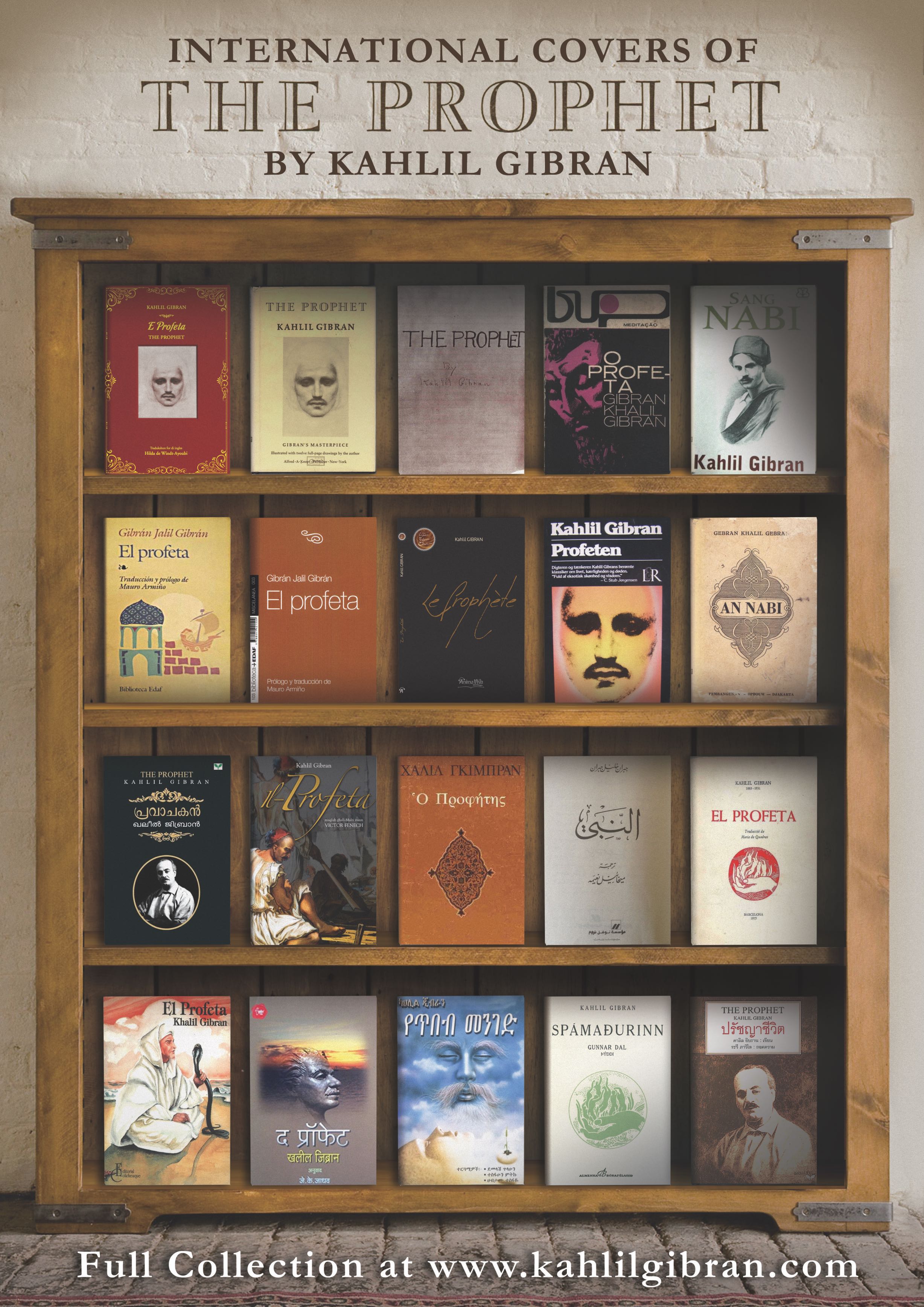 International Book Covers of the Prophet - Photo: The Kahlil Gibran Collective
International Book Covers of the Prophet - Photo: The Kahlil Gibran Collective
To learn more about 'The Artist, The Poet, The Man' please visit the homepage of the Kahlil Gibran Collective.
